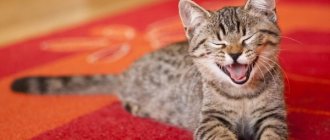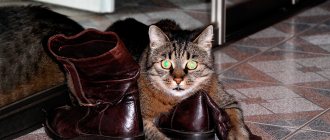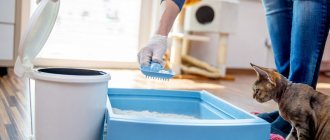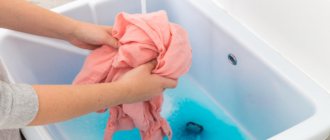No cat owner is immune from the appearance of an unwanted odor in the apartment. Animals may leave marks as they grow older, ignore the litter box due to age, or for psychological or physiological reasons. In any case, dealing with the consequences is quite difficult. Regular wet cleaning does not help achieve the desired freshness, and old stains may not be removed the first time. Here's how to get rid of urine odor quickly with tips from cleaning experts.
Why might there be an unpleasant odor?
There are 2 main causes of unpleasant odors:
- Tags . This is a special cat language with which animals declare their rights to territory. In addition, during puberty, pets use marks to show their readiness to reproduce. Sometimes the cause of this phenomenon may be stress or illness. The smell of a fresh mark is much stronger than the aroma of urine due to the specific secretion it contains.
- Urine . A common problem for cat owners is their cat going to the toilet in the wrong place. Simply washing off urine with water will not work due to the composition of the biological fluid. When urea breaks down, it turns into ammonia crystals with a distinct odor. Urochrome, a coloring pigment, leaves stubborn stains. And uric acid quickly crystallizes and becomes insoluble in water. It is because of the last component that the smell of cat urine is difficult to remove from the apartment, to remove from the surface of textiles, clothing, and furniture.
The cause of an unpleasant “toilet” problem is not always the cat’s bad manners. Perhaps the animal is uncomfortable relieving itself, or it needs help from a veterinarian.
What not to use
Steam generator. Water vapor can only make the situation worse because it does not eliminate the unpleasant odor, but intensifies it. After using the steam generator, the stain becomes more noticeable and the smell becomes stronger.
Preparations containing ammonia. Some cleaning products contain ammonium salts or ammonia. These compounds do an excellent job of removing grease and limescale, but they are powerless against cat urine. All nitrogen-containing substances have a specific odor, similar to the aroma of urine, which can mislead the cat.
Chlorine-containing products . Firstly, it is unsafe for the health of people and animals, and secondly, chlorine tends to enhance odors. Because it reacts chemically with urea.
Substances that mask odor. These are air fresheners, fragrances, deodorants, aromatic oils, coffee beans, etc. Yes, this can camouflage an unpleasant odor, but it is impossible to deceive the sense of smell of animals, so they will again return to where they once “made a puddle.”
Where can the smell appear?
Cat marks and litter box accidents can appear anywhere, from flooring to clothing and bedding. To remove the smell of cat urine and get rid of stains, you need to act as quickly as possible. Immediately after discovering a problem, it is necessary to remove a fresh puddle and neutralize the unpleasant aroma.
Floor
To clean up a puddle, use paper towels or dry rags. Wooden surfaces (laminate, parquet) quickly become saturated with unpleasant odors, so rinsing them with water alone is not enough. Potassium permanganate, peroxide, and iodine will help remove marks and odors after your pet has gone to the toilet in the wrong place. Take about 20-30 drops of the active ingredient per liter of warm water. You can mix water and vinegar in a ratio of 1 to 1. Apply a small amount of the resulting liquid to the floor and wait until it dries completely: decomposition of the constituent components of urine occurs due to absorption.
If you can’t remove the smell from the floor using folk remedies, use professional compounds.
Use aggressive agents (for example, vinegar) only with gloves and not in the presence of an animal - to prevent irritation of the respiratory tract.
Carpet, rug
When removing stains from the surface of a carpet or carpet, the main task is to prevent the stain from spreading. Gently blot the product or flooring with a napkin, and then use baking soda mixed with a small amount of warm water. You can also add dishwashing gel diluted with water. Soda is the most gentle product that does not spoil textiles or change its color.
A solution of water and vinegar in a ratio of 2 to 1 will also help get rid of unpleasant cat odor. After soaking the stain with this product, wait half an hour and blot the treated area with a soft cloth. Then wait until it dries completely.
To remove traces of cat activity from soft surfaces, you should not use potassium permanganate and peroxide, especially in the case of a light-colored coating.
Sofa
A solution with lemon juice will help remove cat urine and get rid of old stains. Squeeze the juice from 1 citrus fruit, mix with a little water and pour the liquid into a spray bottle. After treating the stain, cover it with film. After half an hour, dry the surface with napkins. To consolidate the odor removal effect, you can treat the upholstery with vinegar.
You can also use a weak solution of iodine - 20 drops per half liter of water. A weak solution of potassium permanganate is suitable for dark fabrics. In any case, when planning to solve the problem using improvised means, check the effect of the composition in a small area.
Mattress
You need to get rid of stains and the smell of cat urine as early as possible so that the liquid does not have time to seep deep into the product. You should blot the surface with a dry sponge, without pressing on the mattress, and carefully collect as much liquid as possible. It is necessary to move from the edges of the stain to its middle so that the marks do not spread. The more carefully you act, the better the result will be.
To eliminate odors and stains, it is recommended to use absorbent substances: kitchen salt, baking soda, small granules for cat litter. After half an hour, the residue should be swept away with a brush or vacuumed.
Couldn't solve the problem? You can purchase professional products to remove the smell of cat urine or try a recipe with lemon. Dissolve a teaspoon of citrus juice in a glass of cool water. Wet the stain and blot it after 2 hours, then wait until it dries completely. The composition will help discolor yellow stains. Citrus aroma neutralizes unpleasant odors.
Blanket
If your pet has left a mark or a puddle on the bedding, do not rush to send the soiled textiles to the car. First you need to remove the urine crystals from the fabric, otherwise the unpleasant odor will not be removed. You can start by treating with vinegar (10 tablespoons per 4 liters of warm water). The product is applied locally or used to soak the entire product.
In the case of old stains, baking soda with hydrogen peroxide will work more effectively, but the recipe is only suitable for white fabrics. Dilute a spoonful of soda in a glass of water and treat the stain with the resulting mixture. Then a little peroxide is poured onto it and left for 12 hours. Then the remaining composition is removed with a sponge soaked in water.
For all fabrics, laundry soap containing glycerin is suitable. This component dissolves uric acid crystals, destroys bacteria, and eliminates unpleasant odors. Bed linen is thoroughly washed with soap, rubbed and rinsed.
Wooden furniture
To wash stains from a cabinet/stand/table and remove unwanted odors, it is better to use professional neutralizers. For light-colored unvarnished surfaces, the following recipe is suitable:
- blot the remaining liquid with a sponge;
- Apply a weak vinegar solution to the surface;
- wait until it dries, then sprinkle the treated stain with baking soda;
- after 15 minutes, mix 50 g of 3 percent peroxide with 1 tsp. dishwashing gel and treat the surface with the product;
- After drying, remove any remaining substances with a vacuum cleaner.
Cloth
Saving stained clothes is much easier than removing the smell of cat urine from the floor or mattress. Wash items by hand using laundry soap, and then rinse in a vinegar solution (1 tbsp per 1 liter of water). You can also soak the clothes in a bowl of cold water, adding freshly squeezed juice of 1 lemon. After 1 hour, you can put the item in the washing machine.
Shoes
To remove cat urine odor, first wipe the stain with dry, absorbent wipes. Then pour baking soda into your shoes and pour hydrogen peroxide on top. After 8-12 hours, rinse the treated area thoroughly.
Shoes made of eco- or genuine leather will be saved by glycerin. 1-3 drops of the active component are combined with a soap solution and used to clean boots and shoes. You can treat leather shoes with laundry soap. Grate it, combine with warm water and rinse the soiled items. Don't forget to remove any remaining moisture.
You can remove unpleasant odors from insoles using vinegar wipes and several washing cycles.
To remove stains and unwanted odors, do not use essential oils or air fresheners. They do not remove the smell of cat urine, but mix with crystals of biological fluid. As a result, such products enhance the foul odor. Avoid aggressive chlorine, bleach and products containing ammonia. They are not only ineffective, but also toxic. Chlorine and ammonia are also harmful to many materials.
Odor control products
We'll tell you how to remove the smell left from cat urine using various means. Let's consider folk recipes and professional formulations with proven effectiveness.
Home Remedies
We have compiled the TOP 6 effective folk remedies for removing fresh and old stains, as well as removing the specific smell of marks and urine.
1. Vinegar. The universal composition is prepared from 1 part vinegar and 2 or 3 parts water - depending on the intensity of the unpleasant aroma. Wipe the contaminated area with the resulting liquid. After drying, you can apply baking soda to the treated area, which will neutralize the strong vinegar aroma. You can put the vinegar solution in a spray bottle: this way you can comfortably treat furniture, mattresses, and floor coverings.
2. Soda. This is an excellent product for removing fresh urine stains and marks. Sprinkle baking soda on the stained area and leave it for a while. If the recipe does not help, then pour a little 3% hydrogen peroxide solution on top of the scattered soda. After a few hours, wash the stained item or remove any remaining product from the surface with a wet cloth. The product is often used to clean upholstered furniture and mattresses.
3. Vodka. A cotton pad is moistened with an alcoholic drink or alcohol solution (1 part alcohol and 1 part water), and then wipe the stain with it. Movements should go from the edges to the center. In the case of old stains, leave a disc soaked in alcohol on the stained area for half an hour. The treated area should then dry naturally. Vodka is considered a universal recipe for different types of surfaces.
4. Citric acid. It will not only help get rid of the smell in the apartment, but also prevent the problem from occurring in the future. Cats do not like the aroma of citrus fruits, so most likely the animal will no longer mark or relieve itself in such a place. Universal recipe: juice of 1 lemon and 1 glass of water. The composition is suitable for linoleum, laminate, parquet, carpet, upholstered furniture.
5. Glycerin. Dissolves urea, which is considered the main source of unpleasant odor. Suitable for processing furniture, textiles, shoes. You need to apply a little glycerin from the pharmacy to the stained area or use soap containing glycerin. To enhance the effect, rub the contaminated area a little with a brush (for example, a soft toothbrush). The remaining foam is washed off with a damp sponge.
6. Iodine. Most often used for dark fabrics and floor coverings. 20 drops of iodine are dissolved in a liter of water and then applied to the stain. After 20-30 minutes, the treated area is washed with water at a temperature of about 30 degrees.
Lemon and peroxide have a brightening effect, so these products are not suitable for fabrics that fade.
If the cat has been actively marking or “missing” the toilet lately, then you can put lemon slices, jars of coffee, and chopped onions in the places where he did his tricks. These products can discourage your cat from making a new mark or staining the surface with urine.
Professional household chemicals
Specialized products designed taking into account the specific composition of cat urine and tags will help solve the problem. The most popular products include:
- Odor neutralizer in the form of a spray, Wellroom. Helps eliminate unwanted odors through enzymes that break down organic contaminants. The product will not just kill the smell of the cat, but will destroy the aroma at the molecular level. Effective for neutralizing marks and traces of urine, traces of excrement. It has a pleasant aroma of citrus and cinnamon.
- Nature's Miracle Cat Urine Odor Eliminator Spray. The enzyme-based product is suitable for all types of coatings and even eliminates the smell of feces. Discourages pets' interest in the treated area. Can be used as a spray or foam.
- Liquid odor eliminator Zoo Clean "DezoSan" . A universal concentrate eliminates stench of organic origin, on any surfaces and in the air. Contains no bleach, phosphates or fluorine. Has a deodorizing effect.
- Spray Urine-off Cat & Kitten. Hypoallergenic spray neutralizes the smell of pet urine and cleans any hard or soft surfaces. Copes with old stains. The anti-odor contains pheromone blockers, which help wean the cat from further marking.
- Concentrate SmellOFF. Suitable for getting rid of odors and destroying bacteria in the room. Contains neutral detergent components, natural plant extracts, enzymes. Apply with a spray bottle to those areas of the room that require cleaning.
To eliminate stains and quickly get rid of odors using professional products, strictly follow the manufacturer's instructions.
How to remove an old stain
If for some reason you managed to find a stain left by a cat only after some time, then getting rid of the smell will be much more difficult:
- The main thing is don’t try to save money. High-quality store-bought products are more expensive, but they are also more effective against ingrained odors,
- use vinegar against the ingrained smell of urine, but alcohol, potassium permanganate, peroxide will be practically useless,
- If your clothes or textiles are saturated with the smell of urine, it’s better to just take them to the dry cleaner.
Preventive measures
It is much easier not to deal with the consequences of the problem, but to eliminate the cause of the unwanted aroma in the house. First of all, make sure that your pet is in good health and psychological condition. It is advisable to consult a veterinarian.
When caring for an animal, follow the rules:
- Choose your cat's litter box wisely. It should be 1.5 times longer than the pet's body.
- Install the toilet in a place that is comfortable for the animal. The cat will relieve itself in the litter box provided it is quiet and comfortable. Do not place the toilet next to the door, on an unheated balcony. The noise of household appliances can also scare away a cat.
- Make sure the litter is suitable for your cat. Do not use options with a strong aroma.
- Remember to clean regularly. Cats are clean animals who will not go to an unclean toilet twice in a row. Excrement and contaminated litter must be removed immediately.
The frequency of replacing the filler depends on its type. The absorbent one is changed every 2 days, the clumping one is changed every week. Silica gel ones are completely replaced 2 times a month.
Keep a close eye on your pet's health, pay attention to it, and practice good hygiene to prevent the development of a delicate problem.
Causes of cat misbehavior
The reasons why a cat stopped going to the litter box are not always clear the first time. Sometimes this happens as a result of stress or is revenge on the owner for punishment, but more often such behavior is associated with completely different circumstances. A cat may not go to the litter box for the following reasons:
- Diseases of the genitourinary system. With cystitis and kidney stones, the animal may experience pain and discomfort when trying to go to the toilet. The cat will instinctively avoid pain and stop visiting its litter box. If the owner sees that his pet is acting restless or meowing before emptying his bladder, it is advisable to visit a veterinarian so that he can examine the animal and prescribe the necessary tests.
- Dirty tray. Cats are naturally very clean creatures. They may refuse to use a litter box that is soiled with feces. The cat litter box should be regularly cleaned of feces and the litter in it should be changed.
- Changing cat litter. Sometimes the animal was happy to go to the old tray, but refuses to use the new one. A person cannot understand why a cat might not like a newly acquired litter box, but this often happens. You should never throw away your old tray right away; you may have to put it back in its place.
- Unsuitable filler. If your cat previously went into sawdust and is suddenly offered silica gel granules, she may stop using her litter box. Some of these animals are very conservative and do not like change.
- Strong smell. Sometimes the owner, wanting to better clean and refresh the cat's litter box, uses a detergent with a strong smell. Cats have a very sensitive sense of smell, so a strong smell of citrus or bleach can discourage them from relieving themselves.
- Wrong place. Pets like their litter box to be in a secluded area. It is better to place the container out of sight in a room with dim lighting. It happens that just rearranging the tray solves the problem when the cat shits anywhere.
- Psychological difficulties. These include unfulfilled sexual desire and jealousy towards other animals in the house. If the owner does not intend to breed kittens, it is better to sterilize the cat and she will stop leaving marks. If the animal is simply jealous of the owner for the appearance of a new pet in the apartment, you need to be patient; over time, the tension will disappear.
To understand what exactly is happening to the cat, you need to pay attention to it, watch it. Most problems that arise with pets can be eliminated by simple participation and care.











